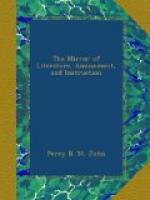Ungrateful Florence! Dante sleeps
afar,
Like Scipio, buried by the upbraiding
shore;
Thy factions, in their worse than civil
war,
Proscribed the bard whose name for evermore
Their children’s children would
in vain adore
With the remorse of ages.
There is a tomb in Arqua; rear’d
in air,
Pillar’d in their sarcophagus,
repose
The bones of Laura’s lover.
* * * * *
They keep his dust in Arqua, where he
died;
The mountain-village where
his latter days
Went down the vale of years; and ’tis
their pride—
An honest pride—and
let it be their praise,
To offer to the passing stranger’s
gaze
His mansion and his sepulchre,
both plain
And simply venerable, such as raise
A feeling more accordant with
his strain
Than if a pyramid form’d his monumental
fame.[12]
[Illustration: (Petrarch’s Tomb.)]
“The tomb is in the churchyard at Arqua. Petrarch is laid, for he cannot be said to be buried, in a sarchophagus of red marble, raised on four pilasters on an elevated base, and preserved from an association with meaner tombs. The revolutions of centuries have spared these sequestered valleys, and the only violence that has been offered to the ashes of Petrarch was prompted, not by hate, but veneration. An attempt was made to rob the sarcophagus of its treasure, and one of the arms was stolen by a Florentine through a rent which is still visible."[13]
The third Memorial is a red porphyry Vase containing the heart of Canova. It is placed in the great hall of the Academy of Arts at Venice, beneath the magnificent picture of the Assumption of the Virgin, by Titian. The vase is ornamented with ormoulu, and bears the inscription Cor magni Canovae, in raised gold letters. M. Duppa describes it as “a vase fit for a drawing-room, not grand, nor lugubrious: it is surmounted with a capsule of a poppy, which is a great improvement on a skull and cross bones.”
Canova was not only the greatest sculptor of his own but of any age. Byron says—
Such as the great of yore, Canova is to-day.
[Illustration: COR MAGNI CANOVAE.]
He was, in great part, self-taught. In one of his early letters, he says, “I laboured for a mere pittance, but it was sufficient. It was the fruit of my own resolution; and, as I then flattered myself, the foretaste of more honourable rewards—for I never thought of wealth.” He wrought for four years in a small ground cell in a monastery. From his great mind originated the founding of the study of art upon the study of nature. His enthusiasm was perfectly delightful: he made it a rule never to pass a day without making some progress, or to retire to rest till he had produced some design. His brother sculptors, hackneyed in the trammels of assumed principles, for a time ridiculed his works, till, at length, in the year 1800, his merits hecame fully recognised; from which time till his death, in 1822, he stood unrivalled amidst the honours of an admiring world.




